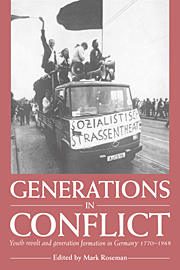Book contents
- Frontmatter
- Contents
- Contributors
- Acknowledgements
- List of abbreviations
- 1 Introduction: generation conflict and German history 1770–1968
- 2 The ideal of youth in late eighteenth-century Germany
- 3 Young Germans and Young Germany: some remarks on the history of German youth in the late eighteenth and in the first half of the nineteenth century
- 4 The battle for the young: mobilising young people in Wilhelmine Germany
- 5 Jewish politics and generational change in Wilhelmine Germany
- 6 The ‘front generation’ and the politics of Weimar Germany
- 7 The New Woman and generation conflict: perceptions of young women's sexual mores in the Weimar Republic
- 8 Generations of German historians: patronage, censorship and the containment of generation conflict 1918–1945
- 9 Gender, generation and politics: young Protestant women in the final years of the Weimar Republic
- 10 The Hitler Youth generation and its role in the two post-war German states
- 11 The BDM generation: a female generation in transition from dictatorship to democracy
- 12 A generation twice betrayed: youth policy in the transition from the Third Reich to the Soviet Zone of Occupation (1945–1946)
- 13 The generation conflict that never was: young labour in the Ruhr mining industry 1945–1957
- 14 The German Kriegskinder: origins and impact of the generation of 1968
- Index
12 - A generation twice betrayed: youth policy in the transition from the Third Reich to the Soviet Zone of Occupation (1945–1946)
Published online by Cambridge University Press: 19 October 2009
- Frontmatter
- Contents
- Contributors
- Acknowledgements
- List of abbreviations
- 1 Introduction: generation conflict and German history 1770–1968
- 2 The ideal of youth in late eighteenth-century Germany
- 3 Young Germans and Young Germany: some remarks on the history of German youth in the late eighteenth and in the first half of the nineteenth century
- 4 The battle for the young: mobilising young people in Wilhelmine Germany
- 5 Jewish politics and generational change in Wilhelmine Germany
- 6 The ‘front generation’ and the politics of Weimar Germany
- 7 The New Woman and generation conflict: perceptions of young women's sexual mores in the Weimar Republic
- 8 Generations of German historians: patronage, censorship and the containment of generation conflict 1918–1945
- 9 Gender, generation and politics: young Protestant women in the final years of the Weimar Republic
- 10 The Hitler Youth generation and its role in the two post-war German states
- 11 The BDM generation: a female generation in transition from dictatorship to democracy
- 12 A generation twice betrayed: youth policy in the transition from the Third Reich to the Soviet Zone of Occupation (1945–1946)
- 13 The generation conflict that never was: young labour in the Ruhr mining industry 1945–1957
- 14 The German Kriegskinder: origins and impact of the generation of 1968
- Index
Summary
For a regime wishing to impose its blueprint on society, winning over the support of youth, or at least neutralising youth's potential for opposition is crucial. Nowhere does this principle seem to have been taken to heart more than in Germany. From the Kaiserreich onwards, German elites devoted enormous energy to influencing the behaviour, life-style and attitudes of the young. Every administration and political party from the extreme left (Karl Liebknecht: ‘He who has the young, has the army’) to the extreme right (Joseph Goebbels: ‘He who has the young has the future’), from party politicians to priests, and from senior civil servants to military figures tried to win young people over to their political goals. Perhaps the most distinctive feature of the German scene was the huge number of associations, leagues and clubs created by the adult world for young people. This development was triggered by the existence of the independent German youth movement, which from the Kaiserreich onwards prompted the established elites to found their own alternatives for young members. From these roots the attempt to shape youth through an organised youth movement broadened and intensified, reaching its highpoint in the Third Reich and the GDR.
Because of the energy and attention devoted to it, youth policy in Germany offers historians a fascinating arena in which to observe the relationship between regime and society. This is particularly so in the phases of breach and transition-in 1914, 1918–19, 1933, 1945 or 1989–90. For one thing, those were the periods when successive regimes' efforts at mobilisation were especially concentrated and energetic.
- Type
- Chapter
- Information
- Generations in ConflictYouth Revolt and Generation Formation in Germany 1770–1968, pp. 247 - 268Publisher: Cambridge University PressPrint publication year: 1995
- 1
- Cited by

